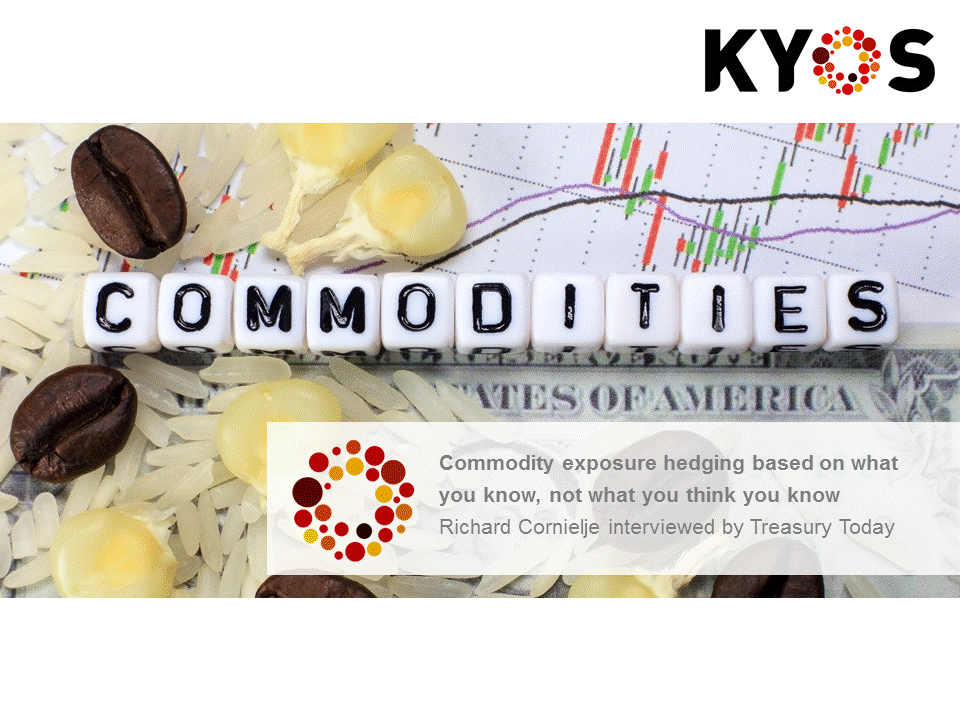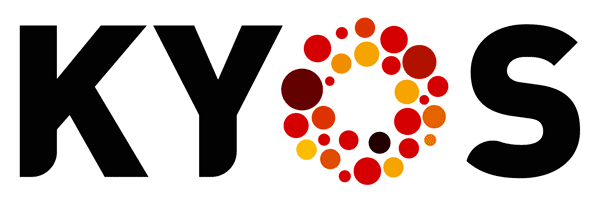Article Treasury Today: Commodity exposure hedging
Commodity exposure hedging based on what you know, not what you think you know
KYOS’ Director for Corporate Clients, Richard Cornielje, spoke with Tom Alford of Treasury Today Group about understanding the importance and difficulties of commodity exposure hedging. This UK based firm publishes a monthly magazine as well as online content about all aspects of treasury management.
 Do you fully understand the commodities risks that lie within the products your company makes? Here’s a way that could help you get to grips with multi-commodity exposures, and hedge more effectively.
Do you fully understand the commodities risks that lie within the products your company makes? Here’s a way that could help you get to grips with multi-commodity exposures, and hedge more effectively.
Commodities trading is one of the oldest forms of trade and so it probably makes sense to listen to the wisdom of the ages when managing the inevitable risk that arises from it. According to Pericles, the influential statesman of ancient Greece, the key is not to try to predict the future, but to be prepared for the future.
As a forward-looking function, there is no doubt that an essential occupation of the treasurer is risk management. Today, one of the common risk mitigants used by corporates, especially those relying on large quantities of commodities, is hedging.
There is a slight problem with this approach, at least in its standard mode. Although most end-products are formed of multiple commodities, many being derived from underlying commodities, risk factors are usually viewed in isolation – and hedged as such.
Richard Cornielje, a corporate commodity advisor, former treasurer, and co-creator of the KYOS Portfolio and Risk Management system, says this approach is inefficient. He believes that companies can make far more informed budget, contract, inventory and market price decisions if they take a multi-commodity exposure view. More effective hedging strategies follow.
Too simplistic
A major food or beverage sector business, for example, captures many of the commodities in use today. It consumes energy, uses a variety of soft commodities in production, has all kinds of packaging requirements including plastics, glass and aluminium.
Despite the complexity of its commodities shopping list, Cornielje notes that budgeting often takes the form of a simple percentage added to last year’s prices. With the volatility of commodities often being in the region of three to four times higher than euro/dollar rates, he says it is useful to be able to calculate the volatility of these different commodities and translate them into potential cash flow movements.
A beverage firm buying aluminium for the manufacture of cans should know that if it does not respond to price volatility of the raw commodity at around 20%, combined with a dollar exchange volatility of around 5%, its potential cashflow movements can be huge. “The importance of risk management in procurement is rapidly increasing,” says Cornielje.
Indeed, taking a ‘last year plus 5%’ approach to budgeting fails to capture the complexity of a product’s relationship to multiple other commodities and their volatility over time.
Price advantage
If a food company has the ability to make a product using either dextrose or sucrose, without an understanding of the risk in the underlying commodities of each, procurement is only likely to consider the prevailing market price of each.
If a best offer for sucrose is €300/ton, whilst dextrose is €305, the knee-jerk response, says Cornielje, is to contract for sucrose. But delve deeper, he advises. Sucrose is linked to the sugar market and dextrose to the wheat market: although the initial price of dextrose is €5 higher, wheat as a commodity is less volatile.
“Buying dextrose and keeping the position open exposes the company to less cash flow volatility; taking sucrose at the lower rate exposes the company to more volatility in the sugar market, compared to wheat,” he explains.
Extrapolate the risk of each option over 12 months, for example, and the outcome is reversed. Drilling down into the risk element of each component, and the production options, makes for an interesting discussion between treasury and procurement, says Cornielje.
Hedging strategy
One vital topic of conversation based on this understanding should be hedging strategy. Aside from advising procurement on any natural currency hedges, where production options exist (to use either aluminium or tinplate for cans, for example), treasurers will know that certain underlying commodities have very narrow hedging windows.
Tinplate can only be hedged for six to nine months because of the market volatility of its underlying commodity, steel. Although initially more expensive, aluminium, can be hedged for several years. Because it is supported by a more liquid market, prices can be fixed.
Making connections
Commodity market data is available from common terminals such as Bloomberg or Reuters, and there are numerous FX and financial derivative marketplaces. Corporates can calculate volatility from these data sources. Cornielje, whose firm KYOS offers a web-based system to store, manage and analyse commodity related contracts, argues that a global industrial manufacturer with multiple instances of SAP and myriad spreadsheets, will struggle to collate the information or be able to respond effectively.
A single system makes the process of testing the volatility and risk of a whole product, or set of products, more manageable, transparent and effective, he argues. “KYOS automatically calculates correlations between the commodities used by a corporate.” Crucially, this includes the underlying and derivative commodities that, for example, connect sucrose to the sugar market, dextrose to the wheat market, and various plastics, via naphtha and benzene trade, to oil.
By applying Monte Carlo simulations of pricing relationships, it gives a sense of price-shift probability over any period. Then, by combining commodity positions with price analytics, inputs can be translated into potential short-term value-at-risk, and longer-term cashflow-at-risk metrics, says Cornielje. Hedging policy has always been defined according to risk appetite and tolerance, only now, those hedges can be built around deep market facts – not supposition.
View original article on Treasury Today
Published 28 July 2019
To view this article in pdf: Commodity exposure hedging article Treasury Today
